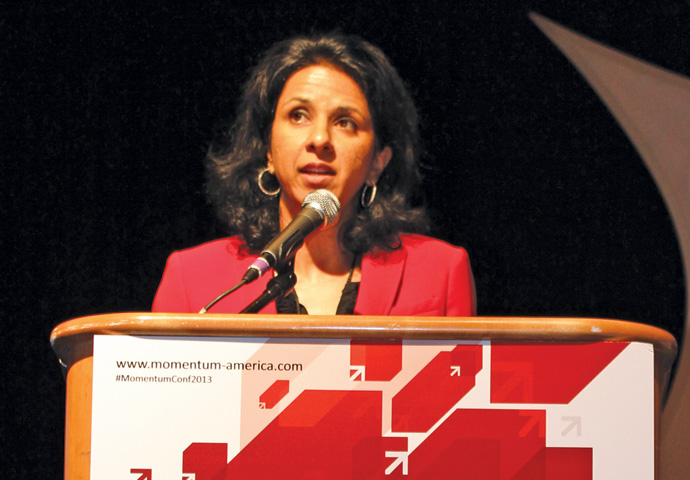Anyone doubting the power of broadband need look no further than the hallways of a Sebeka, Minn., elementary school where students are using iPads to compose music and perfect their batting stances, all using broadband technology.
I recently had the opportunity to see this smart application of broadband technology in a video produced by the community’s telecommunications provider, West Central Telephone Association, which has served the school with advanced communications for nearly a decade. The video chronicles a visit by Sen. Amy Klobuchar where she saw the tremendous impact broadband has made on that community’s schools and students. It reminded me just how important the work that community-based telecommunications providers are doing is to their communities, and provided further evidence that providing rural communities with access to robust broadband networks is the best and sometimes the only way to open these rural and remote locations to the global marketplace.
Because of the unique financial and geographical challenges providers face in these rural areas, they must think outside the box to provide solutions tailor made for their unique circumstances so their communities can share in the prosperity that comes with modern telecommunications technology.
These providers serve more than 40 percent of the nation’s land mass but less than 5 percent of the nation’s telecom subscribers. To meet the specific needs of their communities, they have evolved to become one-stop tech service providers, offering everything from video to wireless services, home security, computer repair and data storage. And they’ve done it all despite the enormous challenges that come with deploying telecommunications infrastructure to rural locations, which are naturally more sparsely populated than urban centers and feature rugged, rocky and mountainous terrain.

The “Rural Is Cool” reception hosted by the NTCA-The Rural Broadband Association at its Fall 2013 conference also recognized the group’s inaugural winners of its Smart Rural Community award, including this group from Kansas.
Photo courtesy of NTCA-The Rural Broadband Association
In the face of these challenges, rural providers have made tremendous strides in deploying high-capacity networks to nearly all of their rural customers over the last decade, enabling our nation’s ongoing evolution to broadband-based communications, both wired and wireless. Results from an annual survey NTCA conducts to study our members’ broadband deployment efforts found that 41 percent of them are currently deploying fiber-optic-based broadband to at least 50 percent of their customers using fiber-to-the-home (FTTH) technologies – up from 33 percent in 2012. Many (about 60 percent) are also deploying wireless communications technologies to their customers, responding to consumer demands for more mobile options as more rural Americans “cut the cord” on traditional wireline telephone services.
The Infrastructure of Learning
A 2011 study by the Hudson Institute found that the rural telecommunications industry supported $14.4 billion of economic impact in 2009, with $9.5 billion occurring in urban areas, and more than 70,000 jobs, 45 percent of which were placed in urban areas.
This contribution does not come without cost, and rural broadband providers have traditionally relied on a vibrant entrepreneurial spirit and the support of our country’s universal service policies to keep up with changing consumer demands and in turn stimulate economic development in their communities.

‘Invest, Deploy And Deliver’
The FCC in July invited formal proposals for federal funding under the Connect America Fund to provide rural broadband experiments in unserved areas. “Rural America deserves more than minimal broadband services, and there are many utilities ready to invest, deploy and deliver,” said Connie Durcsak, president and CEO of the Utilities Telecom Council (UTC), on July 11. More than 200 expressions of interest were filed by utilities in response to the FCC’s January IP Transition Order. “Utilities have extensive infrastructure, including fiber-optic networks that can be leveraged to provide fiber-to-the-home on a cost-effective basis,” said the UTC.
Receiving a strong education is the key to economic success, and having broadband infrastructure in place not only enhances learning but also helps rural areas retain those students who will one day make the tough decision to return home or find work elsewhere. Once again, community-based providers have shown they are dedicated to providing reliable services to learning institutions such as schools and libraries – and improving those services as needs change over time. Small providers are currently deploying some form of broadband services to 96 percent of K-12 schools in their service areas and 98 percent of public libraries.
NTCA launched the Smart Rural Community initiative in 2012. It’s a program designed to foster the development of smart communities across rural America by recognizing innovators and providing resources to assist broadband providers and connected industries. The idea was to focus on communities and communications providers to show how they are improving the lives of their customers and community members through service to anchor institutions such as schools, libraries, hospitals and public safety providers.
We were wowed by the award applications we received outlining the innovative thinking behind their success stories. Seven communities, including Sebeka, were honored last year. And each brought a unique story of how their services are making a difference for their communities:
Blue Valley Tele-Communications Inc., Home, Kan., provides service to healthcare facilities spread across 10,000 square miles. The facilities have access to electronic health records and a picture archive system for remote diagnosis.
DRN, Ellendale, N.D., provides all students in grades 4-12 with iPads. These connected devices enable students to partake in advanced coursework via an ITV system, and enable multiple districts to share resources.
ITS Telecom Inc., Indiantown, Fla., provides services to a high-density secure data center collocation facility in Martin County.
Mutual Telephone Company, Little River, Kan., provides specialized services to a company that produces high-definition stock video and photography.
Nex-Tech, Inc., Hays, Kan., connects the only tertiary-level hospital to broadband services, which enables the rapid transfer of imaging and electronic health records.
Park Region Telephone/Otter Tail Telcom, Underwood, Minn., incorporates a business development center and a telework hotel that offers a range of business solutions to meet the growing needs of businesses in the area.
West Central Telephone Association, Sebeka, Minn., connects public schools in the area to a 10-gig LAN with wireless access supports for simultaneous access by mobile devices, and allows online learning.
Opening Doors

Shirley Bloomfield
NTCA will honor the next round of Smart Rural Communities this fall, and I am excited to see what new gems will be unveiled.
Of course, creating broadband connections is just the first step in building smarter communities. The real work begins once the connections are made. It is then that students can take advantage of distance learning applications that they may not otherwise be exposed to, and farmers will be able to increase productivity through the use of technology. Those connections open doors to job opportunities for the rural workforce and allow small businesses to bring their products to a global market.
In reviewing the latest round of Smart Rural Community hopefuls I continue to be amazed by the forward-thinking mindset community-based providers have. Small telecom providers are leading the smart charge, and these areas thought to be left behind by technology will continue to play a significant role in strengthening rural America and spurring economic prosperity for the entire country.
Shirley Bloomfield is chief executive officer of NTCA – The Rural Broadband Association, an association representing nearly 900 independent, community-based telecommunications companies.
The Outsourcing Opportunity
The inaugural Momentum conference in Atlanta in September 2013 convened to address an opportunity sometimes lost amidst the buzz to bring offshored manufacturing back to North America – the potentially more lucrative chance to bring back outsourced services that also went offshore. Testimonials for domestic sourcing came from such companies as Red Hat, Jostens, IBM and Hudson’s Bay Co.
“Integrating domestic sourcing is something you are going to continue to see more and more of,” said Eugene Kublanov, managing director, Shared Services & Outsourcing Advisory, KPMG LLP, who has watched with interest the reshoring of manufacturing and the inherent flexibility and speed such moves have brought back to the companies who have done it. “This is the right time to do it,” he said, noting projects coming to rural parts of his home state of Arkansas. “If we’re seeing these types of trends in high tech and textiles coming back to the US, certainly the opportunity for domestic sourcing is as great, if not greater.”
“It’s very timely to have this conversation,” said HfS Research founder and CEO Phil Fersht, noting the surprisingly large percentage of payroll, accounts receivable and related work that companies still run in-house. “We’re close to an inflection point. Most of the stuff that’s been outsourced to date has been relatively low-end work – payables, receivables, healthcare claims. A lot is outsourced to India and Latin America. What hasn’t transpired is mid- to high-level work being outsourced. That’s where I think the opportunity is for the US service provider picking up high-level projects from clients.”
Examples of successful partnership include Hudson’s Bay Co.’s growing use of Onshore Outsourcing, based in the small northeastern Missouri town of Macon. Another domestic outsourcing firm, Rural Outsourcing, was launched by CEO Monty Hamilton in rural Arkansas. He operates a second location in Augusta, Ga., and was actively searching for a third.
“People always ask us about the scalability challenge,” said Charles Ruggiero, president and COO, Onshore Outsourcing, of concerns about running out of talent in rural locations. “We’ve effectively run out of runway in Macon. When we started in Macon, unemployment was between 8.5 percent and 9 percent.” In such a small community, each time Onshore hired 50 more people the blip in the graph was significant. “Now it’s down to 5.6 percent,” he said. “We are running out of workers. So we’re having to expand.”

Amrita Joshi, CEO, Ahilia, Inc., speaks at the inaugural Momentum 2013 conference on domestic outsourcing in Atlanta in September 2013.
Happily, in a sense, the US is not running out of small-town locations where people are looking for work. Onshore was growing last fall at a college campus location in Glenville, Ga., where the unemployment rate is 10.6 percent. “So we’ll do just fine there,” said Ruggiero.
Currently, said Fersht, HfS estimates that around 20 percent of global business process outsourcing (BPO) and IT spend goes to the US. According to an HfS/KPMG survey of 200 enterprises, company leaders asked what level of cost savings they’d need to achieve to move work to various countries said 28 percent for China and India (down from 40 percent several years ago). For the US, they only needed to see 17-percent savings to justify the move. But some are seeing more.
“We’re actually saving 30 percent with our US sourcing,” said Mike Heeter of Jostens.
Amrita T. Joshi, CEO of Momentum conference organizer and consulting firm Ahilia Inc., says domestic outsourcing has been largely ignored for a couple reasons.
“One is they think ‘outsourcing’ is a bad word,” she said. “The second reason is the big push with manufacturing, which is fantastic, but there is literally zero focus on the knowledge services industry. It’s ignored.” The proof? “When we have to explain what we do to our relatives,” she said. “We are one of the only countries that does not have an organization to promote it,” she said, noting that the US represents “42 percent of the dollars spent on global outsourcing, and we need more of it here.”
– Adam Bruns
